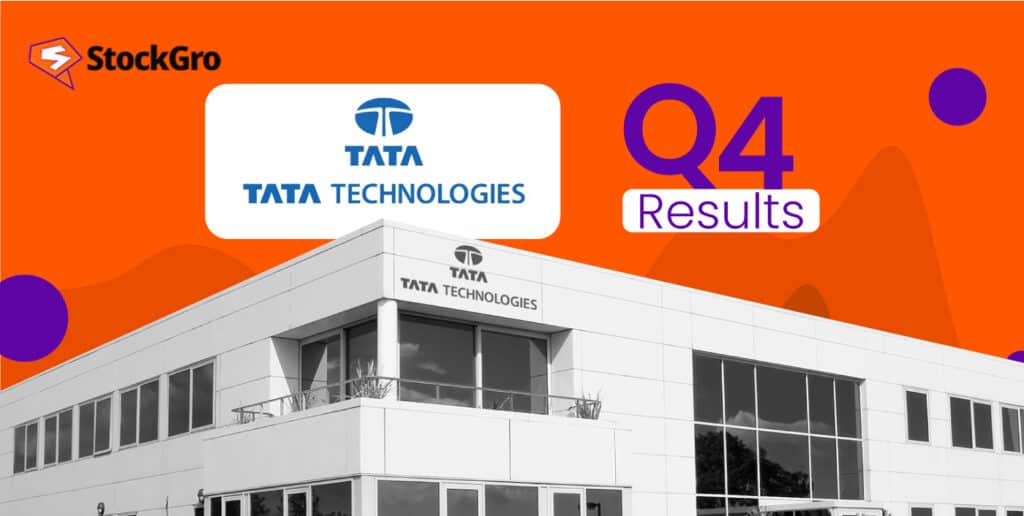
Tata Technologies, a member of the Tata Group, experienced a notable 5% drop in its share prices following the January-March 2024 quarter results. The company, known for its tech-enabled solutions, faced investor scepticism due to subdued earnings reported for the quarter.
This downturn is part of a larger trend, as the shares have seen a significant decline from their peak of ₹1,400 in November 2023. In this blog, we’ll delve into the details and broader impacts of the recent Tata Tech results.
Also read: Tata technologies IPO after 20 years in the TATA conglomerate
About Tata Tech
Tata Technologies Limited (TTL), established in 1994 as Core Software Systems Private Limited, was renamed in 2001 when it became an integral part of the prestigious Tata Group. TTL specialises in engineering and digital solutions, playing a vital role in sectors like automotive, aerospace, and industrial machinery.
Services and products are the company’s two primary business verticals.
The Services business focuses on providing outsourced engineering services and digital transformation solutions to a global manufacturing clientele.
In contrast, the Products and Education business segments offer product lifecycle management (PLM) software and solutions along with educational services on the latest engineering and manufacturing technologies to institutions and enterprises.
Tata Technologies has evolved significantly since its inception, transitioning from a department within Tata Motors dedicated to engineering, research, and development (ER&D) services, to a standalone entity specialising in Digital Enterprise Solutions (DES) and ER&D. Today, the company serves over 100 global clients and maintains 19 global delivery centres in regions including the US, Europe, India, China, and Southeast Asia.
You may also like: Tata Motors announces demerger: Share price surge to cross ₹1000 for first time
Tata Tech Q4 results 2024
Tata Technologies reported its financial results for the fourth quarter of the fiscal year 2024, marking a challenging period for the company. In the quarter ending March 31, 2024, TTL achieved a consolidated net profit of ₹157.24 crore. Compared to the ₹216.56 crore reported during the same period the previous year, this is a 27% reduction. Sequentially, the profit after tax (PAT) also saw an almost 8% decline from ₹170.22 crore in Q3FY24.
Operating revenue for the quarter was ₹1,301.05 crore, down 7.22% from ₹1,402.39 crore in the same period last year. This slowdown was notably influenced by a ramp-down in services from VinFast, a key client, contributing to reduced revenue streams. Despite this, TTL expects the residual impact from VinFast to continue into the first quarter of FY25.
Analysts anticipated that any possible losses would be offset by the expansion of the education sector and strong results from other core clients. To some extent, reality lived up to these expectations. The revenue outside of the VinFast services showed a healthy increase, demonstrating the company’s capability to diversify its revenue base effectively.
For the entire fiscal year, TTL posted a PAT of ₹679.37 crore, up from ₹624.03 crore in FY23, indicating a year-on-year improvement amidst quarterly fluctuations. The company’s total revenue for FY24 also showed a 16% increase compared to the previous fiscal year’s total of ₹4,501.92 crore.
Moreover, TTL signed twelve significant agreements during FY24, including five in the $15–$25 million range and one exceeding $50 million. This demonstrates the company’s ongoing efforts to secure substantial contracts despite current challenges.
| (₹ crore) | Q4 FY24 | Q3 FY24 | Q-o-Q growth | Q4 FY23 | Y-o-Y growth |
| Revenue from operations | 1,301 | 1,289.5 | 0.90% | 1,402.4 | -7.20% |
| Gross profit | 368 | 366.3 | 0.40% | 360 | 2.20% |
| Operating EBITDA | 240 | 236.6 | 1.40% | 242.7 | -1.10% |
| Net income | 157.2 | 170.2 | -7.60% | 216.6 | -27.40% |
| Diluted EPS | 3.87 | 4.19 | -7.60% | 5.33 | -27.40% |
Dividend declared
For the fiscal year ending on March 31, 2024, the board of Tata Technologies suggested a special dividend of ₹1.65 per equity share of ₹2 face value in addition to a final dividend of ₹8.40.
These dividends are pending approval at the upcoming Annual General Meeting (AGM). When approved, the dividends will be paid out or sent to Tata Tech’s existing shareholders three days after the 30th AGM ends.
Also read: Tata Group stocks surge ahead of anticipated Tata Sons IPO
Tata Tech Share price performance
Tata Technologies experienced a notable downturn in its share price following the announcement of subdued Q4 earnings for the fiscal year 2024.
At the Bombay Stock Exchange (BSE), Tata Tech’s stock fell 4.9%, settling at ₹1,032.95. This decline was influenced by several brokerages revising their target prices downward in response to the company’s latest financial results.
On the National Stock Exchange (NSE), the situation mirrored that of the BSE. Around mid-morning trading, Tata Tech shares were trading at ₹1,044.75, marking a decrease of 3.87% from the previous closing price of ₹1,086.80. The shares experienced an intraday low of ₹1,032.70 during the trading session.
These shifts in the Tata Tech share price on NSE and BSE are crucial for investors tracking the impact of quarterly earnings on stock performance.
As of May 7, 2024, Tata Tech stocks have seen a decline of 20.03% over the past year.
Additionally, examining a longer timeline reveals that Tata Tech shares have experienced a negative return of 13.98% over the past five years.
Bottomline
Despite the setbacks faced in the last quarter, Tata Technologies has demonstrated resilience through its strategic contract signings and commitment to shareholder returns via dividends. The company’s proactive measures to navigate client changes and market fluctuations, especially the anticipated adjustments post-VinFast, indicate a robust strategic approach.
Looking forward, Tata Technologies’ focus on expanding its service capabilities and leveraging its global presence will be pivotal for its recovery and long-term growth. Investors and stakeholders can expect the company’s strategic initiatives to gradually reflect in improved financial performance and stock stability in the upcoming periods.
